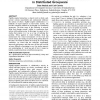Free Online Productivity Tools
i2Speak
i2Symbol
i2OCR
iTex2Img
iWeb2Print
iWeb2Shot
i2Type
iPdf2Split
iPdf2Merge
i2Bopomofo
i2Arabic
i2Style
i2Image
i2PDF
iLatex2Rtf
Sci2ools
CSCW
2008
ACM
2008
ACM
The effects of local lag on tightly-coupled interaction in distributed groupware
Tightly-coupled interaction is shared work in which each person's actions immediately and continuously influence the actions of others. Tightly-coupled collaboration is a hallmark of expert behavior in face-to-face activity, but becomes extremely difficult to accomplish over distributed groupware. The main cause of this difficulty is network delay that disrupts people's ability to synchronize their actions with another person. In this paper we report on two studies that explore local lag as a way of reducing this problem. When applied to visual feedback, local lag synchronizes the visual environments of the local and remote clients, preventing one person from getting ahead of the other. We tested the effects of local lag in several delay conditions: we found that the technique significantly improved performance, and that users did not rate local lag as more difficult or frustrating to use. Our studies improve our understanding of local lag and of how it improves tightly-coup...
| Added | 19 Oct 2010 |
| Updated | 19 Oct 2010 |
| Type | Conference |
| Year | 2008 |
| Where | CSCW |
| Authors | Dane Stuckel, Carl Gutwin |
Comments (0)

